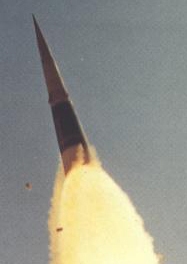Sprint (missile)
| Sprint | |
|---|---|
 Sprint missile in flight | |
| Type | Anti-ballistic missile |
| Place of origin | United States |
| Service history | |
| In service | 1972 |
| Production history | |
| Manufacturer | Martin Marietta |
| Specifications | |
| Mass | 7,700 pounds (3,500 kg) |
| Length | 26.9 feet (8.20 m) |
| Diameter | 53 inches (1.35 m) |
| Warhead | W66 nuclear low kt |
| Engine | 1st Stage: Hercules X-265 (650,000 pounds-force (2,900 kN); 2nd Stage: Hercules X-271 |
Operational range | 25 miles (40 km) |
| Flight ceiling | 19 miles (30 km) |
| Maximum speed | 12,300 kilometres per hour; 7,610 miles per hour; 3,400 metres per second (Mach 10) |
Guidance system | Radio command guidance |
Launch platform | Silo |
The Sprint was a two-stage, solid-fuel anti-ballistic missile, armed with a W66 enhanced radiation thermonuclear warhead. It was designed as the short-range high-speed counterpart to the longer-range LIM-49 Spartan as part of the Sentinel program. Sentinel never became operational, but the technology was deployed briefly in a downsized version called the Safeguard program. The Sprint, like the Spartan, was in operational service for only a few months in the Safeguard program, from October 1975 to early 1976. Congressional opposition and high costs linked to its questionable economics and efficacy against the then emerging MIRV warheads of the Soviet Union, resulted in a very short operational period.
The Sprint accelerated at 100 g, reaching a speed of Mach 10 in 5 seconds. Such a high velocity at relatively low altitudes created skin temperatures up to 6200°F (3400°C), requiring an ablative shield to dissipate the heat.[1][2] It was designed for close-in defense against incoming nuclear weapons. As the last line of defense it was to intercept the reentry vehicles that had not been destroyed by the Spartan, with which it was deployed.
The conical Sprint was stored in and launched from a silo. To make the launch as quick as possible, the cover was blown off the silo by explosive charges; then the missile was ejected by an explosive-driven piston. As the missile cleared the silo, the first stage fired and the missile was tilted toward its target. The first stage was exhausted after only 1.2 seconds, but produced 650,000 lbf (2,900 kN) of thrust. On separation of the spent first stage, it disintegrated due to aerodynamic forces. The second stage fired within 1 – 2 seconds of launch. Interception at an altitude of 1,500 m to 30,000 m took at most 15 seconds.
The Sprint was controlled by ground-based radio command guidance, which tracked the incoming reentry vehicles with phased-array radar and guided the missile to its target.
The Sprint was armed with an enhanced radiation nuclear warhead with a yield reportedly of a few kilotons, though the exact number has not been declassified. The warhead was intended to destroy the incoming reentry vehicle primarily by neutron flux.
The first test of the Sprint missile took place at White Sands Missile Range on 17 November 1965.[3]
Design predecessors

The "HIBEX" (HIgh Boost EXperiment) missile is considered to be somewhat of a design predecessor and competitor to the Sprint missile, as it was a similar high acceleration missile in the early 1960s, with a technological transfer from that program to the Sprint development program occurring.[4] Both were tested at the White Sands Launch Complex 38. Although HIBEX's initial acceleration rate in G's was higher at near 400 G, its role was to intercept reentry vehicles at a much lower altitude than Sprint, 6,100 m, and it is considered to be a last ditch ABM missile "in a similar vein to Sprint".[5] HIBEX employed a star-grain "composite modified double-base propellant", known as FDN-80, created from the mixing of Ammonium perchlorate, Aluminum and Double Base powder with zirconium staples (0.125 inches in length) embedded or "randomly dispersed" throughout the matrix.[6]
The small "Thunderbird" rocket of 1947 produced an acceleration of 100 G with a polysulfide composite propellant, star-grained cross section solid rocket motor.[7]
Engines and propellant
The first stage's Hercules X-265 engine is believed to have contained alternating layers of zirconium "staples" embedded in nitrocellulose powder, followed by gelatinizing with nitroglycerine, thus forming a higher thrust double-base powder.[8][9]
Survivors
- The Air Defense Artillery museum at Fort Sill, Oklahoma has both Safeguard missiles (Sprint and Spartan), plus Nike Zeus and HIBEX on exhibit.[10][11][12]
- The White Sands Missile Range Museum has a HIBEX on exhibit.
See also
- 53T6
- Anti-ballistic missile
- Surface-to-air missile
- LIM-49 Spartan
- Nike-Hercules missile
- Project Nike
- Safeguard Program
References
- ^ Sprint
- ^ Designation-systems Directory of U.S. Military Rockets and Missiles. Martin Marietta Sprint
- ^ James Walker, Lewis Bernstein, Sharon Lang (2005). Seize the High Ground: The U.S. Army in Space and Missile Defense (PDF). Government Printing Office. ISBN 0160723086.
17 November 1965 First guided SPRINT flight test took place at WSMR
{{cite book}}: CS1 maint: multiple names: authors list (link) - ^ III. HIBEX - UPSTAGE
- ^ Sprint
- ^ UpSTAGE TECHNOLOGY REPORT:SPECIAL MANUFACTURING AND FABRICATION 1972. McDonnell Douglas. pg 162-178, with impact sensitivity on G-24
- ^ http://www.astronautix.com/articles/comlants.htm
- ^ Up-ship. Sprint missile
- ^ DTIC. by SB Moorhead - 1974
- ^ http://www.city-data.com/articles/US-Army-Air-Defense-Artillery-Museum-El.html
- ^ http://srmsc.org/mis2050.html
- ^ ADA park (Fort Sill), photo journal of Daniel DeCristo
External links
- Sprint
- Directory of U.S. Military Rockets and Missiles
- Terminal defense using the Sprint
- Sprint missile launch
- Nike Sprint dual launch during a salvo test at Kwajalein Atoll test range
- Video of Nike Sprint launch (2 MB .mpg)
- Encyclopedia Astronautica - Sprint
- Chapter 9: Sprint Missile Subsystem from ABM Research and development at Bell Labs
- Nike Sprint and Spartan Photo Gallery
